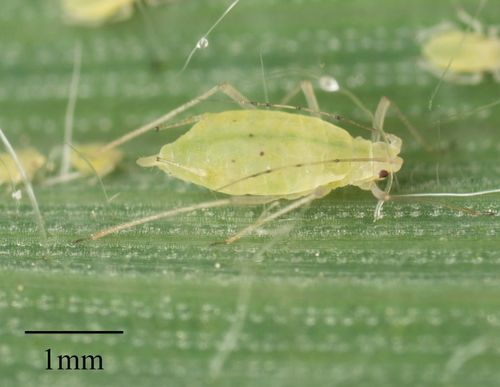Rose-grain aphid (Metopolophium dirhodum)
Biology and life history: Rose-grain aphid is a common cereal pest in the Pacific Northwest, USA. Wingless forms of rose-grain aphids are medium-sized, shiny, and yellowish green. The winged form has a dark green mid-dorsal stripe and pale antennae with darkly pigmented joints. It is holocyclic (having annual sexual phase) in its native range, but no sexual phase has been detected in its invasive range in North America. Females give birth to live young on host plants year around. Rose-grain aphid frequently co-occurs in wheat systems with the newly invasive and visually similar species, cereal grass aphid. Wingless forms of the two species can be distinguished based on the lack of horizontal bands on the abdomen of rose-grain aphids. Also, unlike cereal grass aphids, feeding of rose-grass aphid feeding does not produce the pigmented chlorotic and necrotic patches on leaves.
Host plants and crop damage: In addition to feeding and colonizing rose (Rosa spp.) plants worldwide as its main overwintering host, rose-grain aphid attacks a wide range of cereal crops (e.g., wheat, barley, oat) and other grasses (e.g., meadow foxtail, wildrye, bunchgrass, and wheatgrass). Compared to other cereal aphids (e.g., English grain aphid and cereal grass aphid), this pest is relatively less abundant in the Pacific Northwest, USA. Although its feeding may occasionally damage cereal crops and reduce yields, unlike some other aphids, this pest does not inject toxins while feeding and causes limited injury. Additionally, some studies indicated this aphid as a vector of Barley yellow dwarf virus and others in the cereal yellow dwarf virus complex, but it is considered an inefficient vector.
Management: Rose-grain aphid is attacked and regulated by various natural enemies such as lady beetles, ground beetles, lacewings, spiders, hoverflies, and parasitic wasps. Hence, cultural controls such as crop rotation and cropping system diversification help manage this pest. In areas with high rose-grain aphid abundance, growers are encouraged to scout their crop fields regularly during the crop growing season. There are currently no control strategies explicitly developed for this aphid, but growers can use the management threshold to other aphids, whose phenology, occurrence, and injury level are similar to this pest.

